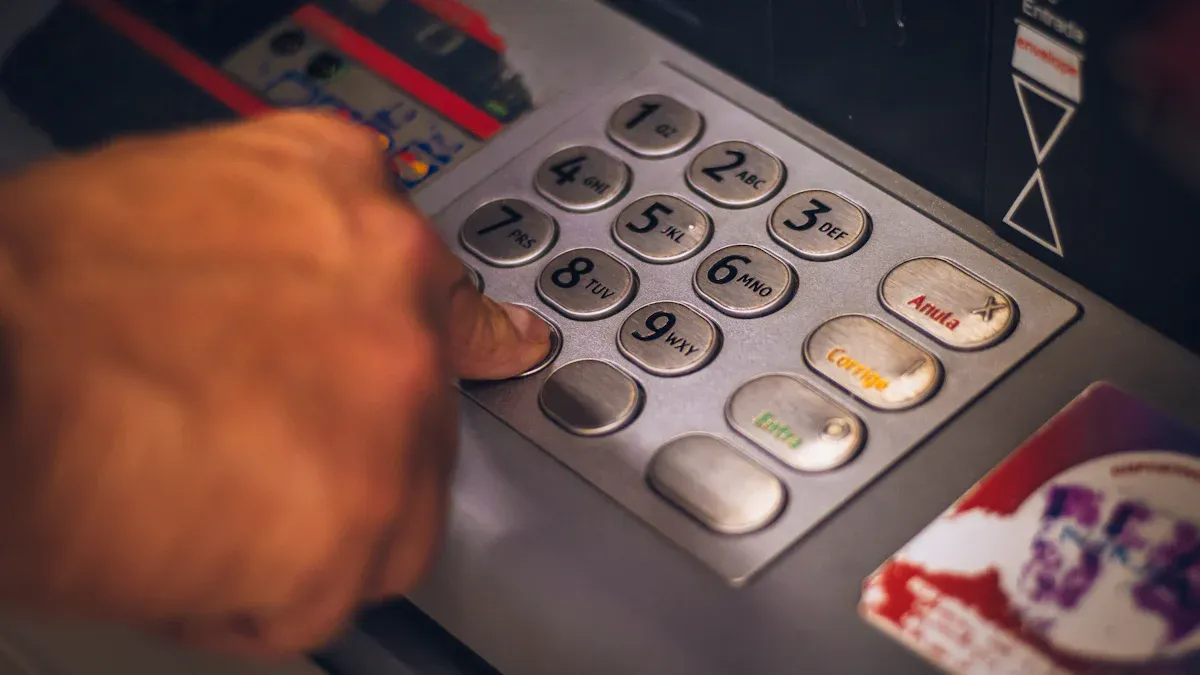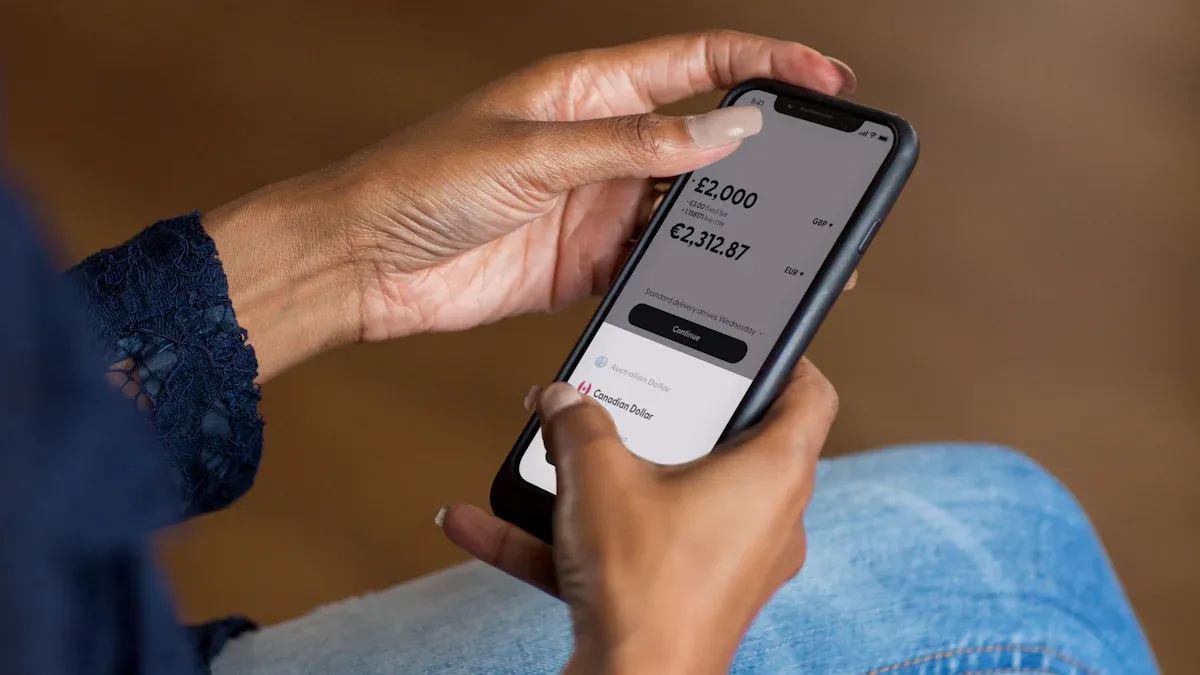- EasyCard
- Trade
- Help
- Announcement
- Academy
- SWIFT Code
- Iban Number
- Referral
- Customer Service
- Blog
- Creator
Comprehensive Guide to SWIFT Code: Beginners Easily Master International Remittance

Image Source: unsplash
When you want to make an international remittance, the first question you’ll ask is: “How do I find the correct SWIFT code in Chinese?” In fact, you can use Google search, visit the official website of a Hong Kong bank, or call the bank’s customer service to find the answer. Over 90% of international trade relies on remittances, and the SWIFT code ensures your money reaches the recipient’s account safely and quickly. As long as you follow simple steps to check, you can easily handle international remittances.
Key Points
- The SWIFT code is a mandatory bank identification code for international remittances, ensuring funds reach the recipient’s account safely and quickly.
- To check the SWIFT code, it’s best to use the bank’s official website or customer service to ensure the information is accurate and up-to-date.
- When using Google or third-party platforms to check, be cautious about the source of the information to avoid errors.
- Before remitting, always verify the SWIFT code and recipient details to avoid failed transfers and additional fees.
- Protect personal information and avoid entering sensitive data on unknown websites to ensure remittance safety.
What is SWIFT Code in Chinese?
Explanation of SWIFT Code in Chinese
You often hear about SWIFT code in Chinese, but what exactly is it? In fact, SWIFT code in Chinese is the Bank Identifier Code (BIC), which stands for “Society for Worldwide Interbank Financial Telecommunication.” This code is managed by the global SWIFT organization and is used to identify different banks and financial institutions worldwide. Every time you make an international remittance, the bank will require you to provide the SWIFT code in Chinese, as this ensures your money is sent safely and accurately to the recipient’s account.
According to financial industry statistics, the SWIFT code in Chinese consists of 8 to 11 characters, and every bank globally has its unique code. This code is not only used for international remittances but also for handling cross-border payments, foreign currency transfers, and other financial transactions. As long as you enter the correct SWIFT code in Chinese, the bank can quickly identify the recipient bank, reducing the chance of errors.
Tip: The SWIFT code in Chinese is different from Hong Kong’s local bank codes, which are only used for local transfers in Hong Kong. International remittances must use the SWIFT code in Chinese.
Structure and Format
The structure of the SWIFT code in Chinese is very systematic, making it easy to understand at a glance. It consists of four parts:
- Bank Code (4 letters): Represents the bank’s name
- Country Code (2 letters): Represents the country where the bank is located
- Location Code (2 letters): Represents the city or region
- Branch Code (3 letters, optional): Represents a specific branch
You can refer to the table below to see the SWIFT codes in Chinese for common Hong Kong banks:
| Bank Name | SWIFT Code |
|---|---|
| CITIC Bank International | KWHKHKHH |
| The Hongkong and Shanghai Banking Corporation | HSBCHKHH |
| Bank of China | BKCHHKHH |
| Standard Chartered Bank | SCBLHKHH |
| Fubon Bank | IBALHKHH |
| The Bank of East Asia, Limited | BEASHKHH |
| Industrial and Commercial Bank of China | UBHKHKHH |
| Dah Sing Bank, Limited | DSBAHKHH |
| Chong Hing Bank Limited | LCHBHKHH |
As long as you know the recipient bank’s SWIFT code in Chinese, you can confidently proceed with international remittances. BIC and SWIFT code in Chinese are actually the same thing, just called differently. Next time you see these two terms, you won’t get confused!
Methods to Check SWIFT Code

Image Source: unsplash
If you want to check the SWIFT code in Chinese, there are many methods available. Each method has its pros and cons, and you can choose the most convenient one based on your needs. However, no matter which method you use, always prioritize official resources to ensure safety and accuracy.
Official Website Inquiry
If you want the most accurate SWIFT code in Chinese, checking directly on the bank’s official website is the most reliable option. Major Hong Kong banks publish their SWIFT codes on their official websites. You just need to:
- Open the recipient bank’s official website
- Search for the “International Remittance” or “SWIFT Code” section
- Find the SWIFT code in Chinese for the corresponding branch or service
Official website data is protected by multiple security measures, including message source identification, message integrity, non-reusability, and non-repudiation. Banks use high-strength encryption technologies (e.g., 3DES, AES, RSA, ECC) and digital signatures to ensure the data you check is accurate and cannot be tampered with. Each time you inquire or enter data, the system uses one-time random numbers and timestamps to prevent data reuse, along with multi-factor authentication (e.g., biometrics or certificates) to verify your identity. These measures are designed based on financial regulations and technical standards, allowing you to check with confidence on official websites.
Tip: Official websites usually have the latest SWIFT code in Chinese. If you have any doubts, you can directly contact the bank’s customer service for confirmation.
Google Search Tips
Sometimes, if you want to quickly find the SWIFT code in Chinese, you can use Google search. However, you need to be cautious because not all online information is accurate. You can do the following:
- Enter “Bank Name + SWIFT Code” in Google
- Prioritize clicking on search results with “.hk” or the bank’s official website
- Check if the webpage has official logos or contact information
If you find the source of the information unclear or the webpage looks poorly designed, stay alert. It’s best to cross-check with the bank’s official website to ensure the data is correct.
Note: Google search is convenient and fast, but you need to carefully verify the source to avoid using outdated or incorrect SWIFT codes in Chinese.
Third-Party Platforms
Nowadays, many third-party platforms, such as Wise and Airwallex, offer SWIFT code in Chinese inquiry services for global banks. These platforms typically:
- Provide a database of SWIFT codes for banks in multiple countries
- Support multilingual interfaces
- Include user reviews and inquiry records
You can directly enter the bank name or country on these platforms to quickly find the required SWIFT code in Chinese. However, third-party platform data may not always be updated in real-time, so it’s recommended to cross-check with the official website after finding the code.
Tip: Third-party platforms are suitable for preliminary inquiries, but you must confirm with official data before making a remittance.
Bank Customer Service
If you’re not confident about online inquiries or encounter special situations, you can directly call the bank’s customer service. You just need to:
- Prepare the recipient bank’s name and branch details
- Call the bank’s official customer service hotline
- Ask the customer service representative for the latest SWIFT code in Chinese
Bank customer service will provide the most accurate information based on your needs. This method is particularly suitable for those unfamiliar with online operations or needing to check the SWIFT code in Chinese for specific branches.
Tip: When calling to inquire, verify the customer service representative’s identity to avoid scams.
When using the above methods to check, remember to protect your personal information and avoid entering sensitive data on unknown websites. Official websites and bank customer service are the most reliable sources, while third-party platforms and Google search can serve as supplementary references. As long as you stay cautious, checking the SWIFT code in Chinese will become quick and safe.
Precautions for Checking
Data Accuracy
When checking the SWIFT code, the most important thing is to ensure the data is accurate. If you use the wrong SWIFT code, the money may not reach the recipient’s account, or it may be returned, incurring additional fees. You can:
- Prioritize checking on the bank’s official website or calling customer service
- Note down the complete SWIFT code and bank name after checking
- Verify the data again before remitting
Sometimes, third-party website data may not be updated in real-time. It’s best not to rely on a single source. You can check multiple websites and use official data as the final reference. This significantly reduces the chance of errors.
Tip: If you’re unsure whether the SWIFT code is correct, ask a bank staff member directly for the safest option.
Personal Information Protection
When checking the SWIFT code, you may need to enter your bank details. Be careful to protect your personal information and avoid entering account numbers, passwords, or ID numbers on unknown websites. You can:
- Only check on the bank’s official website or recognized platforms
- Avoid sending sensitive information to strangers
- Use a secure network environment, such as your home Wi-Fi
If you receive suspicious emails or calls asking for the SWIFT code or other personal information, stay alert. Banks will not proactively ask for your password or one-time verification codes.
Note: Protecting personal information is protecting your wallet, so never be careless.
Code Validity
SWIFT codes may change due to bank mergers, branch adjustments, or policy changes. Don’t assume a SWIFT code from a few years ago is still valid. You should:
- Check the latest SWIFT code before each remittance
- Pay attention to bank announcements or updates on the official website
- If the recipient bank has branches, ensure you check the SWIFT code for the correct branch
Some banks publish updated SWIFT code lists on their websites. You can regularly check to ensure you’re using the latest data. This prevents remittance failures due to expired codes, which could incur additional fees (e.g., return fees of 10-30 USD, depending on the bank and exchange rate).
Reminder: SWIFT codes are not set in stone. Regularly check for updated information to ensure smoother remittances.
International Remittance Applications

Image Source: unsplash
Filling Steps
To successfully complete an international remittance, just follow these steps:
- Prepare the recipient’s details, including the recipient bank’s name, SWIFT code in Chinese, account number, and English name.
- Check the correct SWIFT code in Chinese using Google search, the bank’s official website, a foreign currency passbook, or the SWIFT official inquiry page.
- When filling out the remittance application form, enter the 8-digit or 11-digit SWIFT code in Chinese as required by the bank. In the remarks field, include the recipient’s English name and account number to help the recipient bank identify the transfer.
- You can choose to fill out the form yourself or ask bank staff for assistance. Some banks offer dedicated services for VIP customers.
- After completing the remittance, the bank will give you a receipt. It’s recommended to take a photo or scan it for future reference. Generally, the funds will arrive within about 8 hours.
Tip: Always double-check the data before each remittance to ensure the SWIFT code in Chinese and recipient details are correct.
Differences Between SWIFT Code in Chinese, Bank Code, and IBAN
You might confuse SWIFT code in Chinese, Bank Code, and IBAN. In fact, they each serve different purposes:
- SWIFT Code in Chinese: Used to identify banks globally and is mandatory for international remittances. Hong Kong banks all have their own SWIFT codes in Chinese.
- Bank Code: Mainly used for local transfers, such as Hong Kong bank codes, and is usually not needed for international remittances.
- IBAN: Stands for International Bank Account Number, primarily used in Europe, the Middle East, and other regions. Hong Kong banks generally don’t require IBAN, but you’ll need it when remitting to European banks.
Just remember: International remittances always require the SWIFT code in Chinese, IBAN is needed for Europe, and Bank Code is for local transfers.
Fees and Processing Time
International remittance fees and processing times vary by bank. You can refer to the table below for common banks’ fee structures (in USD, actual fees may vary with exchange rates):
| Bank Name | Handling Fee (USD) | Telegraph Fee (USD) | Other Fee Notes | Estimated Arrival Time |
|---|---|---|---|---|
| The Hongkong and Shanghai Banking Corporation | 15~30 | 10~20 | Overseas bank fees charged separately | 1~2 working days |
| Standard Chartered Bank | 15~30 | 10~20 | Overseas bank fees charged separately | 1~2 working days |
| Bank of China | 15~30 | 10~20 | Full amount transfer adds 20~30 | 1~2 working days |
| SinoPac Commercial Bank | Fixed 7 | 13 | Full amount transfer adds 25 | Approx. 8 hours |
| E.Sun Commercial Bank | 5~30 | 10 | Foreign currency settlement fee 0, telegraph fee 15 | Approx. 8 hours |
Note: If you choose “full amount transfer,” the bank will charge additional overseas bank fees. Fees and arrival times vary by bank and country. It’s recommended to ask the bank beforehand to avoid overpaying.
Quick Reference for Hong Kong Banks’ SWIFT Codes
Want to quickly find the SWIFT codes for Hong Kong banks? Here’s a quick reference table for the most commonly used SWIFT codes in Chinese for Hong Kong banks. Just check the table to instantly find the code you need. These data are sourced from the banks’ official websites, giving you confidence when checking.
| Bank Name | SWIFT Code | Remarks |
|---|---|---|
| The Hongkong and Shanghai Banking Corporation | HSBCHKHH | Main Branch |
| Bank of China (Hong Kong) | BKCHHKHH | Main Branch |
| Standard Chartered Bank (Hong Kong) | SCBLHKHH | Main Branch |
| The Bank of East Asia | BEASHKHH | Main Branch |
| CITIC Bank International | KWHKHKHH | Main Branch |
| Fubon Bank (Hong Kong) | TPBKHKHH | Main Branch |
| Dah Sing Bank | DSBAHKHH | Main Branch |
| Chong Hing Bank | LCHBHKHH | Main Branch |
| ICBC Asia | UBHKHKHH | Main Branch |
Tip: When remitting, use the correct SWIFT code in Chinese. If you’re transferring to a branch, confirm with the recipient bank, as some branches have specific codes. Check the data each time before remitting to ensure it’s up-to-date.
You can save this table for future reference. Next time you need to make an international remittance, just check it to save time and feel secure. If you can’t find a specific bank’s SWIFT code in Chinese, call the bank’s customer service or visit the official website. This is the safest way to minimize errors.
You’ve now mastered several methods to check SWIFT codes, including official websites, Google search, third-party platforms, and bank customer service. Remember, official resources are the most reliable, and you must double-check the data before remitting.
Tip: Protect personal information and avoid entering sensitive data on unknown websites.
As long as you pay attention to data accuracy, international remittances will be safer. Try it now to reduce doubts and ensure every remittance goes smoothly!
FAQ
Is There a Difference Between SWIFT Code and BIC?
There’s actually no difference. When you see SWIFT Code or BIC, they mean the same thing—bank identifier code. The two terms are just called differently.
What Happens If I Enter the Wrong SWIFT Code?
If you enter the wrong SWIFT Code, the bank may return the funds. You’ll also need to pay a return fee, typically around 10 to 30 USD, depending on the bank and exchange rate.
Do Hong Kong Banks’ SWIFT Codes Change Frequently?
Hong Kong banks’ SWIFT codes rarely change. However, codes may be updated during bank mergers or branch adjustments. You should check the latest data before each remittance.
What Else Do I Need to Fill Out Besides the SWIFT Code for Remittances to European Banks?
For remittances to European banks, besides the SWIFT Code, you need to fill out the IBAN. IBAN is the international account format used by European banks, which Hong Kong banks generally don’t use.
Can I Check SWIFT Codes Using Mobile Apps?
You can check SWIFT codes using most Hong Kong banks’ mobile apps. Just log into the app and search for the “International Remittance” or “SWIFT Code” section to quickly find the information you need.
Mastering SWIFT Code lookups ensures secure international transfers, but how can you minimize costs and maximize efficiency? BiyaPay offers a seamless platform supporting USD, HKD, and 30+ fiat and digital currency conversions with real-time exchange rate tracking.
Global remittances to 190+ countries feature transfer fees as low as 0.5%, with swift delivery. Trade US and Hong Kong stocks without offshore accounts and grow wealth with a 5.48% annualized yield savings product. Sign up for BiyaPay today for smarter transfers and investments!
*This article is provided for general information purposes and does not constitute legal, tax or other professional advice from BiyaPay or its subsidiaries and its affiliates, and it is not intended as a substitute for obtaining advice from a financial advisor or any other professional.
We make no representations, warranties or warranties, express or implied, as to the accuracy, completeness or timeliness of the contents of this publication.




Contact Us
Company and Team
BiyaPay Products
Customer Services
is a broker-dealer registered with the U.S. Securities and Exchange Commission (SEC) (No.: 802-127417), member of the Financial Industry Regulatory Authority (FINRA) (CRD: 325027), member of the Securities Investor Protection Corporation (SIPC), and regulated by FINRA and SEC.
registered with the US Financial Crimes Enforcement Network (FinCEN), as a Money Services Business (MSB), registration number: 31000218637349, and regulated by FinCEN.
registered as Financial Service Provider (FSP number: FSP1007221) in New Zealand, and is a member of the Financial Dispute Resolution Scheme, a New Zealand independent dispute resolution service provider.




















